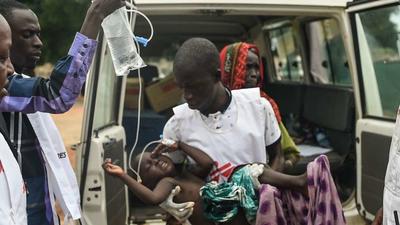Dr Esther Sterk arrived in the Philippines earlier this week to assist in MSF’s response to Typhoon Haiyan. Her team has been travelling to the remote islands west of Cebu where four in five houses are in ruins, and water sources have been contaminated by seawater from the massive storm surge.
“Tacloban City has been the major focus of the aid effort, but the damage in other places is also huge. Yesterday, we managed to reach some areas in Panay, Negros and Bantayan Islands.
The eastern part of Panay Island has been heavily affected. In some villages, 80 percent of the houses have been partially or completely destroyed.
A lot of roofs and walls have fallen or been torn apart. In many cases, the whole house has completely collapsed.
In the next days, we will focus on the isolated villages along the coast and on the surrounding islands.
At the moment we do not know if healthcare is functioning there, but medical facilities are likely to be destroyed.
Need for food and water
People tell us that they need drinking water, because the lakes have become salty when the seawater surged.
In the rural areas, many people have no means of subsistence, as their crops have been destroyed.
Usually, those living on small islands travel from one island to another by boat, but many boats have been ruined. Sick people have no way of reaching the main island.
On bigger islands, communities are working to clear the roads that are covered with falling trees.
Lack of shelter
The hospital that we visited in Roxas City, in the northern part of Panay, has been damaged but is still functioning.
Local medical staff have done what they can to cope with the first wave of patients who suffered from fractures and wounds due to falling objects.
It has been raining a lot and survivors have no shelter, so we are now preparing for a second wave of patients.
Medical staff in Roxas City are already seeing cases of respiratory infections and diarrhoea, and we expect the number of cases to increase.
We will support the medical facilities with staff, drugs and medical equipment. We also plan to carry out mobile clinics to remote villages and small islands.
Risk of malaria and leptospirosis
We need to be fast – with the floods, there are a lot of mosquitoes. We are worried about an increase in malaria and dengue cases.
Leptospirosis, a disease from contaminated water, is also a threat, as it is endemic in this part of the Philippines.
We are focused on providing aid fast to the most isolated areas. Tomorrow, two teams will go back to the eastern coast of Panay by helicopter and by boat.
They will take medication with them and will identify the areas for the mobile clinics, in order to go as close as possible to the people in need.”
Here from Facebook? Prefer to donate in a different country?
Select a country below or from our list:
Find out more about MSF's work in the Philippines





